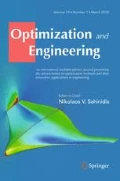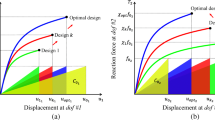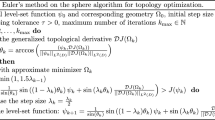Abstract
We consider equivalent reformulations of nonlinear mixed 0–1 optimization problems arising from a broad range of recent applications of topology optimization for the design of continuum structures and composite materials. We show that the considered problems can equivalently be cast as either linear or convex quadratic mixed 0–1 programs. The reformulations provide new insight into the structure of the problems and may provide a foundation for the development of new methods and heuristics for solving topology optimization problems. The applications considered are maximum stiffness design of structures subjected to static or periodic loads, design of composite materials with prescribed homogenized properties using the inverse homogenization approach, optimization of fluids in Stokes flow, design of band gap structures, and multi-physics problems involving coupled steady-state heat conduction and linear elasticity. Several numerical examples of maximum stiffness design of truss structures are presented.
Similar content being viewed by others
References
Adams W, Forrester R, Glover F (2004) Comparisons and enhancement strategies for linearizing mixed 0–1 quadratic programs. Discret Optim 1:99–120
Allaire G (2002) Shape optimization by the homogenization method. Springer, New York
Ambrosio L, Buttazzo G (1993) An optimal design problem with perimeter penalization. Calc Var 1:55–69
Bendsøe M (1989) Optimal shape design as a material distribution problem. Struct Optim 1:193–202
Bendsøe M (1995) Optimization of structural topology, shape, and material. Springer, Berlin
Bendsøe M, Kikuchi N (1988) Generating optimal topologies in structural design using a homogenization method. Comput Methods Appl Mech Eng 71(2):197–224
Bendsøe M, Sigmund O (2003) Topology optimization: theory, methods and applications. Springer, New York
Bollapragada S, Ghattas O, Hooker J (2001) Optimal design of truss structures by logical-based branch and cut. Oper Res 49(1):42–51
Borel P, Harpøth A, Frandsen L, Kristensen M, Shi P, Jensen J, Sigmund O (2004) Topology optimization and fabrication of photonic crystal structures. Opt Express 12(9):1996–2001
Borrvall T, Petersson J (2003) Topology optimization of fluids in Stokes flow. Int J Numer Methods Eng 41:77–107
Cook R, Malkus D, Plesha M, Witt R (2001) Concepts and applications of finite element analysis, 4th edn. Wiley, New York
Dorn W, Gomory R, Greenberg H (1964) Automatic design of optimal structures. J Méc 3:25–52
Eschenauer H, Olhoff N (2001) Topology optimization of continuum structures: a review. Appl Mech Rev 54(4):331–390
Fischetti M, Lodi A (2003) Local branching. Math Program 98:23–47
Gibiansky L, Sigmund O (2000) Multiphase composites with extremal bulk modulus. J Mech Phys Solids 48:461–498
Glover F (1975) Improved linear integer programming formulations on nonlinear integer programs. Manag Sci 22(4):455–460
Glover F (1984) An improved MIP formulation for products of discrete and continuous variables. J Inf Optim Sci 5:469–471
Grossman I, Voudouris V, Ghattas O (1992) Mixed-integer linear programming formulations of some nonlinear discrete design optimization problems. In: Floudas C, Pardalos P (eds) Recent advances in global optimization. Princeton University Press, Princeton
Guedes J, Kikuchi N (1990) Preprocessing and postprocessing for materials based on the homogenization method with adaptive finite element methods. Comput Methods Appl Mech Eng 83:143–198
Haftka R (1985) Simultaneous analysis and design. AIAA J 23(7)
ILOG (2004) ILOG Cplex 9.0 user’s manual and reference manual. ILOG Inc. http://www.ilog.com
Jensen J, Sigmund O (2002) Phononic band gap structures as optimal designs. In: Proceedings of the IUTAM symposium on asymptotics, singularities, and homogenization in problems of mechanics, Liverpool, July 8–11 2002
Jog C (2002) Topology design of structures subjected to periodic loading. J Sound Vib 253(3):687–709
Nemhauser G, Wolsey L (1999) Integer and combinatorial optimization. Wiley, New York
Sigmund O (1994) Design of material structures using topology optimization. PhD thesis, Department of Solid Mechanics, Technical University of Denmark. DCAMM Report S 69
Sigmund O (1995) Tailoring materials with prescribed elastic properties. Mech Mater 20:351–368
Sigmund O (1998) Topology optimization in multiphysics problems. In: Proceedings of the 7th AIAA/USAF/NASA/ISSMO symposium on multidisciplinary analysis and optimization, pp 1–9
Sigmund O (2000) A new class of extremal composites. J Mech Phys Solids 48:397–428
Sigmund O (2001a) Design of multiphysics actuators using topology optimization, part I: one-material structures. Comput Methods Appl Mech Eng 190(49–50):6577–6604
Sigmund O (2001b) Design of multiphysics actuators using topology optimization, part II: two-material structures. Comput Methods Appl Mech Eng 190(49–50):6605–6627
Sigmund O, Jensen J (2002) Topology optimization of elastic band gap structures and waveguides. In: H. Mang, F. Rammerstorfer, and J. Eberhardsteiner (eds) Proceedings of the fifth world congress on computational mechanics WCCM V, Vienna, July 7–12 2002
Sigmund O, Jensen J (2003) Systematic design of phononic band gap materials and structures by topology optimization. Philos Trans Math Phys Eng Sci 361(1806):1001–1019
Sigmund O, Torquato S (1996) Composites with extremal thermal expansion coefficients. Appl Phys Lett 69(21):3203–3205
Sigmund O, Torquato S (1997) Design of materials with extreme thermal expansion using a three-phase topology optimization method. J Mech Phys Solids 45:1037–1067
Stolpe M, Kawamoto A (2005) Design of planar articulated mechanisms using branch and bound. Math Program 103(2):357–398
Stolpe M, Svanberg K (2003) Modeling topology optimization problems as linear mixed 0–1 programs. Int J Numer Methods Eng 57(5):723–739
Svanberg K (1987) The method of moving asymptotes—a new method for structural optimization. Int J Numer Methods Eng 24:359–373
Svanberg K (2002) A class of globally convergent optimization methods based on conservative convex separable approximations. SIAM J Optim 12(2):555–573
Zhou M, Rozvany G (1991) The COC algorithm, part II: topological, geometry and generalized shape optimization. Comput Methods Appl Mech Eng 89:197–224
Author information
Authors and Affiliations
Corresponding author
Additional information
The research is funded by the Danish Natural Science Research Council and the Danish Research Council for Technology and Production Sciences.
Rights and permissions
About this article
Cite this article
Stolpe, M. On the reformulation of topology optimization problems as linear or convex quadratic mixed 0–1 programs. Optim Eng 8, 163–192 (2007). https://doi.org/10.1007/s11081-007-9005-3
Received:
Revised:
Published:
Issue Date:
DOI: https://doi.org/10.1007/s11081-007-9005-3




